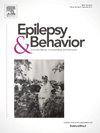约旦大学医院癫痫患者对癫痫手术的认识、态度和认知。
IF 2.3
3区 医学
Q2 BEHAVIORAL SCIENCES
引用次数: 0
摘要
癫痫是一种与耻辱和相当高的发病率相关的疾病,给患者及其家庭带来了重大负担。重要的是要注意到,鉴于全球对癫痫手术的利用不足,大量患者仍然不了解在许多情况下显示出巨大成功的有效外科手术。在本研究中,我们探讨约旦大学医院癫痫患者对ES的知识和态度。目的:本研究旨在评估JUH癫痫患者对ES的态度和知识,确定影响其态度的变量,并将结果与其他中东和西方报告进行比较。方法:在这项横断面研究中,我们于2023年3月1日至9月1日进行,收集并分析了JUH神经内科门诊癫痫患者的数据。采用自我管理的问卷,问题强调患者的人口统计学,疾病状况,以及他们对ES的知识和态度。为了确定态度的影响因素,采用SPSS软件对单变量分析进行logistic回归。结果:本研究纳入145名参与者,其中大多数在17岁和29岁年龄组,平均首次发作年龄为21.6岁。我们的样本包括更多的全身性癫痫患者,而不是局灶性癫痫患者,另外30%的患者不知道他们特定的癫痫发作类型。46%的患者至少服用2种抗癫痫药物(aed),尤其是局灶性癫痫组,61%的患者对药物没有依从性。82名参与者(57%)意识到ES,但只有25人表现出高度的理解。大多数患者(77%)对ES持积极态度。虽然患者的态度与他们对ES的第一印象、年龄、第一次发作的年龄和没有驾驶执照显著相关,但回归模型没有显示显著的预测因子。尽管94%的患者认为ES有中度至高风险,但这对他们的最终态度没有任何显著影响。此外,我们的研究结果表明,收入、保险类型、教育程度、癫痫发作频率和学习成绩差对患者对ES的最终态度没有显著影响。结论:ES不再被认为是“实验性”或“最后手段”的治疗选择。结果强调了教育干预的重要性,以提高对ES的认识和理解,并实施手术预评估潜在候选人的措施。应该进行进一步的研究,以克服和解决这种利用不足方面的差距。在我们的研究中,我们得出结论,这种差距仍然存在,特别是在那些有需要的人身上,可能是ES的潜在候选者,但随着我们大多数患者表现出积极的态度,我们乐观地认为,剩余的障碍可以被克服,我们的研究结果将有助于患者生活质量的积极进步。本文章由计算机程序翻译,如有差异,请以英文原文为准。
Knowledge, attitude and perception of epilepsy patients toward epilepsy surgery at Jordan University hospital
Introduction
Epilepsy is a condition associated with stigma and considerable morbidity, placing a significant burden on patients and their families. It is fundamental to be mindful of the fact that a substantial number of patients remain unaware of the effective surgical procedures that have shown great success in many cases, drawing upon the global underutilization of epilepsy surgery (ES). In this study, we explore the knowledge and attitudes of epilepsy patients towards ES at Jordan University Hospital (JUH).
Aim
This study aims to evaluate epilepsy patients’ attitudes and knowledge regarding ES at JUH, identify the variables affecting their attitudes, and compare the results with other Middle Eastern and Western reports.
Methods
In this cross-sectional study, conducted between the 1st of March and the 1st of September 2023, we gathered and analyzed data from epilepsy patients in the neurology clinic at JUH. A self-administered questionnaire was utilized, with questions emphasizing patients’ demographics, disease status, and their knowledge and attitude toward ES. In order to determine the predictors of attitude, logistic regression was performed on the univariate analysis using the SPSS software.
Results
This study included 145 participants, most of them within the 17 and 29 age group, and a mean age at first seizure of 21.6 years. Our sample included more generalized than focal epilepsy patients, with an additional 30 % of patients being unaware of their specific seizure type. 46 % of patients were on at least 2 antiepileptic drugs (AEDs), especially among the focal epilepsy group and 61 % were non-adherent to their medications. Eighty-two participants (57 %) were aware of ES, yet only twenty-five have shown a high level of understanding. The majority of patients (77 %) have expressed a positive attitude towards ES. Although patients’ attitude was significantly associated with their first impression towards ES, age, age at first seizure and not possessing a driving license, the regression model did not reveal significant predictors. Despite the perception of 94 % of the patients that ES has a moderate to high risk, this did not have any significant influence on their final attitude. Furthermore, our results concluded that income, insurance type, educational level, frequency of seizures, and poor academic outcome played no significant role in patients’ final attitude towards ES.
Conclusion
ES is no longer considered an “experimental” or “last resort” treatment option. The results emphasize the importance of adapting educational interventions to improve knowledge and understanding of ES and implement measures to surgically pre-evaluate potential candidates. Further research should be done to overcome and address this gap in underutilization. In our study, we conclude that this gap is still present especially in people who are in need and may potentially be candidates for ES, but with the displayed positive attitude in the majority of our patients we are optimistic that the remaining barriers can be overcome, and that the results obtained from our study will be helpful for positive advancements in patients’ quality of life.
求助全文
通过发布文献求助,成功后即可免费获取论文全文。
去求助
来源期刊

Epilepsy & Behavior
医学-行为科学
CiteScore
5.40
自引率
15.40%
发文量
385
审稿时长
43 days
期刊介绍:
Epilepsy & Behavior is the fastest-growing international journal uniquely devoted to the rapid dissemination of the most current information available on the behavioral aspects of seizures and epilepsy.
Epilepsy & Behavior presents original peer-reviewed articles based on laboratory and clinical research. Topics are drawn from a variety of fields, including clinical neurology, neurosurgery, neuropsychiatry, neuropsychology, neurophysiology, neuropharmacology, and neuroimaging.
From September 2012 Epilepsy & Behavior stopped accepting Case Reports for publication in the journal. From this date authors who submit to Epilepsy & Behavior will be offered a transfer or asked to resubmit their Case Reports to its new sister journal, Epilepsy & Behavior Case Reports.
 求助内容:
求助内容: 应助结果提醒方式:
应助结果提醒方式:


